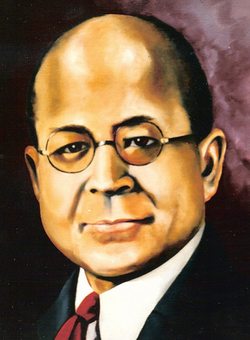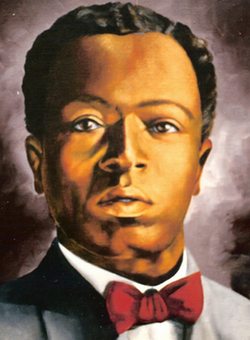 Founder Elder Watson Diggs, was quiet, polished, scholarly, a prolific writer and commonly referred to as ‘the Father of Kappa’. He was born in Hopkinsville, Christian County, Kentucky, on December 23, 1883, and was the eldest son of three children. Diggs and his brother (William Ellis) and sister (Effie) were reared by their mother, Cornelia.
Founder Elder Watson Diggs, was quiet, polished, scholarly, a prolific writer and commonly referred to as ‘the Father of Kappa’. He was born in Hopkinsville, Christian County, Kentucky, on December 23, 1883, and was the eldest son of three children. Diggs and his brother (William Ellis) and sister (Effie) were reared by their mother, Cornelia.
He received a one-room school education in Louisville, Kentucky, where he helped teach the younger children. Following graduation from Indiana State Normal School in the spring of 1908, Diggs enrolled at Howard University in 1909. While a student there, he developed a friendship with fellow Hoosier, Byron K. Armstrong.
During the summer of that year, Byron Armstrong visited his cousin, Irven Armstrong at Indiana University. Bryon was so impressed that he persuaded Diggs to enroll with him in the fall. Diggs enrolled at Indiana University in the fall of 1910 and was the first African-American to graduate with an A.B. degree from Indiana University’s School of Education in 1916. He subsequently earned his Master’s degree of Education from Howard University in 1944.
Diggs was an educator who held teaching positions and served as principal at public schools throughout Indiana. Diggs was married on three occasions (Clara Bell Smith, Elizabeth Byrd and Lyla P. Roberts). Clara Bell and Lyla were both teachers and Diggs assumed Clara Bell’s teaching responsibilities once they became married since female teachers were not permitted to teach in the state of Indiana at that time. Clara Bell and Elizabeth preceded Diggs in death and Lyla died less than 30 days after Diggs passed.
When the U.S. made its declaration in World War I against Germany, Diggs resigned as principal and entered the nation’s first Negroes Officers Training Camp at Fort Des Moines, Iowa and was commissioned a First Lieutenant. After serving in Europe with the 368th Infantry, he rose to the rank of Captain in the Army Reserve Officers Training Corps. Diggs also was a past commander of the American Legion. Subsequent to the war, Diggs was instrumental in having the Indiana constitution amended to permit Negro enlistment in the Indiana National Guard.
Diggs was an active member of the First Baptist Church of North Indianapolis; a past commander of the Edward S. Gaillard Post of the American Legion; a member of the History Committee of the Indianapolis Public Schools; a member of the Leadership Training Committee, Boy Scouts of America; a worker in the YMCA; and during the late war served on the Executive Committee of the USO. Diggs was also a member of Central Lodge No. 1, Indianapolis, Indiana under the auspices of the Most Worshipful Prince Hall Grand Lodge of Indiana.
Based on the hostile attitude and circumstances facing Blacks at Indiana University, Diggs decided to establish a fraternity on campus to give African-Americans support and sanctuary based on high Christian ideals and the purpose of achievement. Diggs assisted Byron & Irven Armstrong in designing the Coat of Arms, assumed responsibility for preparing the initiation ceremonial forms, completed the fraternity’s constitution and took a course in Greek heraldry and mythology to ensure the fraternity was rooted in authenticity. He was one of two Founders who pawned his watch to pay for the Fraternity’s incorporation fee.
Diggs wrote the lyrics to the Kappa Hymn. Additionally, he established the Kappa Alpha Nu Journal, the first periodical of any national Black college fraternity. He served as Grand Polemarch for the first six years of the fraternity’s existence. He also served as a Grand Board Member and as Grand Historian. He also established several of the initial undergraduate chapters in addition to the Indianapolis (IN) Alumni Chapter. Diggs was awarded the first Past Grand Polemarch’s medal and the first Laurel Wreath. He also assisted in writing The 1928 Handbook of Kappa Alpha Psi.
The Elder Watson Diggs Award, the second highest award available to celebrate a member’s achievements or service to the fraternity is dedicated in his name. The Elder W. Diggs Memorial at Indiana University was constructed in his honor in 1962. Diggs died November 8, 1947. Following his death, School #42 was named in his honor where he served as principal for 26 years. Diggs is laid to rest at Crown Hill Cemetery, Indianapolis, Indiana.


 Founder John Milton Lee, a scholar, loyal and tireless worker for the growth of the Fraternity and because of his idealist character was commonly referred to as ‘a dreamer’, was born in Danville, Indiana on September 7, 1890 and was the third of four children.
Founder John Milton Lee, a scholar, loyal and tireless worker for the growth of the Fraternity and because of his idealist character was commonly referred to as ‘a dreamer’, was born in Danville, Indiana on September 7, 1890 and was the third of four children. Founder Guy Levis Grant, small in stature, but a giant in charitable endeavors and preserver of history, was born in New Albany, Indiana on April 9, 1891 and was the third of thirteen children, five of which became members of the Fraternity. When his father died, he became head of household and assumed responsibility for educating himself and his siblings.
Founder Guy Levis Grant, small in stature, but a giant in charitable endeavors and preserver of history, was born in New Albany, Indiana on April 9, 1891 and was the third of thirteen children, five of which became members of the Fraternity. When his father died, he became head of household and assumed responsibility for educating himself and his siblings. Irvin and the other Founders endured and persevered acts of racial hatred and hostility as students, then organized this fraternity dedicated to the principles of achievement and to alleviate the isolation and raise the sights of Black undergraduates. Irvin left the University following the spring term of 1911.
Irvin and the other Founders endured and persevered acts of racial hatred and hostility as students, then organized this fraternity dedicated to the principles of achievement and to alleviate the isolation and raise the sights of Black undergraduates. Irvin left the University following the spring term of 1911. Founder George Wesley Edmonds,witty in nature and an enigma to most in the Fraternity was born in Knight Township, Vanderburgh County, Indiana on August 13, 1890, as the eldest of two sons.
Founder George Wesley Edmonds,witty in nature and an enigma to most in the Fraternity was born in Knight Township, Vanderburgh County, Indiana on August 13, 1890, as the eldest of two sons.